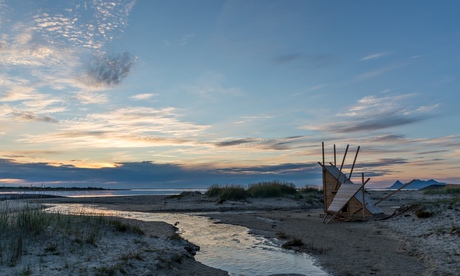
The world's largest sauna, a black-metal band playing rocks, deer-hide drums and a goat horn, and experimental films projected onto a giant rack for drying fish are just some of the attractions hoping to lure visitors to Salt, the world's first Arctic arts festival.
From Friday, the 400-strong population of Sandhornøya, a remote Norwegian island 90 minutes' drive from the nearest big town, promises to be swelled by festivalgoers ready to explore what organisers call "an Arctic state of mind" through art, music, architecture and food.
Most of the action will be concentrated on a beach on the island's northern tip, 2km long and 300 metres wide. "It has this really special white sand," said architect and artist Joar Nango, who is Sami, the indigenous people of the area. "Right behind there's a 500-metre-tall, black mountain wall which is totally vertical. In the wall, there are eight pairs of eagles nesting. It's a magical place."
Nango has built three shelters on the beach where visitors will be able to stay. Sleeping four apiece, they are based on traditional Sami storage houses called njalla. Nango's dwellings are built on skis so can be pulled around the beach, and have a glass roof to view the northern lights.
Other accommodation includes traditional Sami tents, with a floor of reindeer skin laid over birch twigs. "It gives a lot of warmth to the room," said Nango.
For the festival, Sami Rintala of Rintala Eggertsson Architects has built three "arctic pyramids", all based on traditional fish-drying racks, a nod to the area's first dominant industry exporting dried, salted cod to countries like Spain and Brazil. One has been designed to show a video installation by the Chinese artist Yang Fudong, which will be projected on it throughout the night.
The second building is a concert hall, and the third is what Rintala, a Finn, claims is the world's biggest sauna.
"The Finnish military might have something for 50-100 people but we are 110-120, depending on how close you want to sit to someone half-naked." Thanks to a glass wall at the end of the building, Rintala added, festivalgoers will be able to sweat watching the sun set in the Arctic Atlantic.
The festival was co-founded by Erlend Mogård-Larsen and curator Helga-Marie Nordby, who got the idea after working on an art biennial in Lofoten, Norway in 2010. The pair spent two years searching northern Norway for a suitable location before alighting on Sandhornøya.
"When we came here there was no doubt," said Nordby on the eve of the festival. "Right now the sun is shining and it's totally quiet – normally there is a lot of wind. It's just amazing."
Despite the island's small population, Nordby and Rintala say that the local populace have embraced the festival. "The mayor – he's more like a sheriff – welcomed us with open arms," said Nordby. "There are 24 people who own the rights to the beach and all of them immediately said they wanted us to do [the building projects]."
"I'm representing the local voices and I feel very respected and listened to," said Nango. "The festival is a wonderful initiative that's done something a lot of art projects have tried to do, which is a global, contemporary cultural theme with a very grounded local context."
Indigenous performers like the Sami singer Elle Márjá Eira will be playing with acts like "arctic ambient" musician Biosphere; Wardruna, a black-metal-affiliated band who play traditional Norwegian instruments; and musicians from the Arctic Philharmonic Orchestra, who will be performing on the beach.
The festival will continue for a full year before moving to seven more northern locations for a year apiece. Greenland is next, with locations in Scotland and Ireland being pondered by Nordby and Mogård-Larsen.
Before that, Salt has to brave its first winter. Temperatures on Sandhornøya can plunge to -20C (-4F), and the festival's architecture will be buffeted by the sea. "It can get quite rough. Dealing with the weather is part of the project, but it's stronger than us," said Nordby, adding that she would be philosophical if Salt ended up getting washed out to sea. "If you're getting too cold you can just jump into the sauna."
Rintala, who lives locally, said that the island was more than ready for its first arts festival. Far from worrying that visitors will spoil it, "we want to show the beauty of nature here to people who wouldn't otherwise come. Art, music and good food are the basic pillars of civilisation, and we feel very comfortable supporting them."

